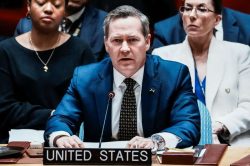
U.S. Federal Reserve Chairman Jerome Powell speaks during a press conference after the release of the Fed policy decision to leave interest rates unchanged, at the Federal Reserve in Washington, U.S, September 20, 2023.
17:04 JST, June 13, 2024
WASHINGTON, June 12 (Reuters) – The Federal Reserve held interest rates steady on Wednesday and pushed out the start of rate cuts to perhaps as late as December as policymakers sketched out their view of an economy that remains virtually unchanged across its major dimensions for years to come.
With growth and unemployment lodged at levels better than the U.S. central bank considers sustainable in the long run, Fed Chair Jerome Powell said policymakers were content to leave rates where they are until the economy sends a clear signal that something else is needed – through either a more convincing decline in price pressures or a jump in the unemployment rate.
So far, Powell noted in a press conference after the end of a two-day policy meeting, inflation had fallen without a major blow to the economy, and he said there was no reason to think that can’t go on.
“These dynamics can continue as long as they continue,” Powell said. “We’ve got a good strong labor market. We think we’ve been making progress toward the price stability goal. We’re asking … is our policy stance about right? And we think yes, it’s about right.”
The result is the Fed accepting a slow expected decline in inflation back towards its 2% target, with the central bank’s preferred inflation measure – the personal consumption expenditures (PCE) price index – virtually unchanged at the end of this year from its current level and the number of rate cuts held to a single quarter-percentage-point reduction.
Those rate reductions are projected to gather pace next year, with Powell deferring on the timing.
“We don’t make decisions about future meetings until we get there,” he said. “Really, it’s going to be not just the inflation readings. It’s going to be the totality of the data, what’s happening in the labor market, what’s happening with the balance of risks, what’s happening with the forecasts, what’s happening with growth. You’re looking at all of that.”
Inflation data published hours before the release of the policy statement and updated projections showed the consumer price index (CPI) rose not at all on a month-to-month basis in May, causing some analysts to argue the latest projections were already “stale.”
Powell’s characterization of the inflation projections as “kind of conservative” indicated the Fed chief was “keeping the door very much open to a September cut” if inflation continues to weaken, said Krishna Guha, vice chairman of Evercore ISI.
Investors in contracts tied to the Fed’s benchmark interest rate largely kept bets intact that the central bank would approve quarter-percentage-point reductions in September and December.
Powell himself said the decision about the rate path was a “close call” for many policymakers, and that to some degree the Fed had merely traded an earlier start to rate reductions this year by tacking an additional anticipated cut onto 2025.
Still, he called the decision to start policy easing “consequential,” and the drop in expectations for this year completes a broad swing in sentiment from just six months ago when policymakers in their December 2023 forecasts envisioned an imminent kickoff to three years of steady rate reductions.
Under the current projections, absent a surprise in upcoming inflation or jobs data, the cuts would likely not begin until December, moving the Fed’s decision out of the Nov. 5 U.S. presidential election cycle.
HIGHER NEUTRAL RATE
The policy statement issued on Wednesday combined an acknowledgement of “modest further progress” on inflation in recent months with a restatement of language that rate reductions won’t be appropriate until officials have “gained greater confidence” that price pressures will continue to ease.
The PCE price index increased at a 2.7% annual rate in April; the median projected by policymakers for the end of the year is 2.6%, with a full return to the 2% target in 2026.
The weak CPI number for May was “only one reading,” Powell said. “When we are (more confident), then we can look at loosening policy.”
The S&P 500 and Nasdaq Composite stock indices closed sharply higher on the day, while the U.S. dollar and yields on U.S. Treasuries fell.
“The market cares more than the economy does about whether there are two cuts this year or only one,” said Brian Jacobsen, chief economist at Annex Wealth Management. “The Fed is basically rearranging the rate-cut deck chairs” from 2024 to 2025.
The new Fed projections show the economy is still expected to grow at a slightly above-trend 2.1% this year despite a sluggish first quarter, and the unemployment rate will remain at its current 4% through the year.
“Recent indicators suggest that economic activity has continued to expand at a solid pace. Job gains have remained strong, and the unemployment rate has remained low,” the Fed said in its statement, which was approved unanimously.
Along with trimming the number of rate cuts expected this year, the new rate projections raised the long-run “neutral” rate needed to keep inflation in check while maintaining steady growth to 2.8% from 2.6%.
The long-run rate has now moved up more than a quarter of percentage point over the Fed’s last two sets of projections, a possible sign officials feel inflation will be harder to tame in the future.
Powell said the increase in the long-run rate did not necessarily influence officials’ short-run projections for the benchmark interest rate, but noted they were still mulling just how restrictive monetary policy had become.
The Fed raised rates aggressively in 2022 and 2023 to curb inflation that had surged to a 40-year high in the aftermath of the COVID-19 pandemic.
“We’re making policy with the economy that we have, with the distortions that we have,” Powell said. “The question of how restrictive this policy has become is one that everyone’s asking … I think the evidence is pretty clear. This policy is restrictive and is having the effect we would hope for.”
"News Services" POPULAR ARTICLE
-

American Playwright Jeremy O. Harris Arrested in Japan on Alleged Drug Smuggling
-

Japan’s Nikkei Stock Average as JGB Yields, Yen Rise on Rate-Hike Bets
-

Japan’s Nikkei Stock Average Licks Wounds after Selloff Sparked by BOJ Hike Bets (UPDATE 1)
-

Japan’s Nikkei Stock Average Buoyed by Stable Yen; SoftBank’s Slide Caps Gains (UPDATE 1)
-

Japanese Bond Yields Zoom, Stocks Slide as Rate Hike Looms
JN ACCESS RANKING
-

Tokyo Economic Security Forum to Hold Inaugural Meeting Amid Tense Global Environment
-

Keidanren Chairman Yoshinobu Tsutsui Visits Kashiwazaki-Kariwa Nuclear Power Plant; Inspects New Emergency Safety System
-

Imports of Rare Earths from China Facing Delays, May Be Caused by Deterioration of Japan-China Relations
-

University of Tokyo Professor Discusses Japanese Economic Security in Interview Ahead of Forum
-

Japan Pulls out of Vietnam Nuclear Project, Complicating Hanoi’s Power Plans
























